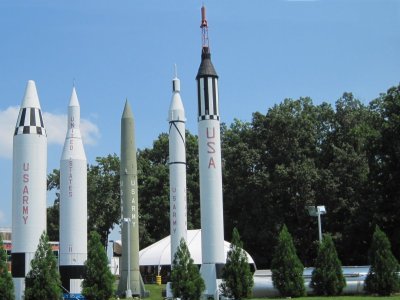
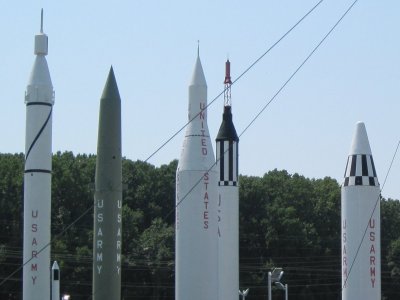
Left to Right: Jupiter, Juno II, Redstone, Juno I,
Mercury-Redstone, NASA Atlas (on its side)
From Another Angle
Early US Launch Vehicles
Satellites, Monkeys and Project Mercury
Compiled by Kimble D. McCutcheon
Unless Noted Otherwise, Photographs by Kimble D. McCutcheon
| After WWII ended, the US transferred a number of captured V-2 rockets, along with many of the scientists and engineers who had developed them, to Fort Bliss, Texas and White Sands Proving Ground, New Mexico. Here, US Army personnel studied, test fired, modified and experimented with the V-2s, and began forming the basis of US missile designs. Many of the missiles that found a role in US space exploration (or replicas thereof) are on display at the USSRC, and are covered below in chronological order. More detailed articles will describe the Redstone, Jupiter and Atlas launch vehicles. |
 |
 |
| Early US Launch Vehicles Left to Right: Jupiter, Juno II, Redstone, Juno I, Mercury-Redstone, NASA Atlas (on its side) |
Early US Launch Vehicles From Another Angle |
Redstone (PGM-11), developed at Redstone Arsenal near Huntsville, Alabama, used technology similar to the V-2, but was enlarged to accommodate an atomic weapon weighing 6,900 lb. It was the US Army's first Medium Range Ballistic Missile. First test-fired in 1953, it was operational by 1958, and was deployed by the US Army in Germany until mid-1964. It had a length of 69.3 ft and weighed 61,300 lb. Using ethanol and LOX for propellants, it had a thrust of 78,000 lb, was capable of 3,700 mph and had a range of about 200 mi. Chrysler was the airframe contractor.
Jupiter (PGM-19) was an evolutionary step up from the Redstone, and with a range of about 1,850 mi, was the US Army's first Intermediate Range Ballistic Missile. Built by Chrysler, it was 60 ft long and weighed 110,000 lb. Burning RP-1 (Rocket Propellant-1, a highly-refined kerosene) and LOX, it had a thrust of 150,000 lb. Jupiter missiles were deployed to Turkey and Italy, but later removed after the Cuban Missile Crisis of 1961. Jupiters were used to test reentry vehicles, nose cone materials, and even successfully launched monkeys into space.
Juno I launched Explorer 1, the first successful US satellite, on 31 January 1958. The Juno I was a Jupiter-C with the addition of a fourth stage consisting of a modified Sergeant solid rocket motor. The Jupiter-C was a modified Redstone first stage with lengthened propellant tanks and a higher thrust engine, which burned hydyne (60% unsymmetrical dimethylhydrazine and 40% diethylenetriamine) for fuel with LOX oxidizer. The Jupiter-C second and third stages consisted of clusters of eleven and three modified Sergeant solid rocket motors. The Juno I fourth stage was spun up to 750 rpm before launch in order to stabilize it, thereby eliminating the need for upper-stage guidance. When launched, Juno I with Explorer 1 was 69.6 ft long and weighed 64,000 lb.
Juno II was essentially a Jupiter first stage with Juno I second, third and (optional) fourth stages. It was used for ten satellite launch attempts between 1958 and 1961. The Juno II was 78.7 ft long and weighed about 121,000 lb.
Mercury-Redstone launched the first two Americans into space when Alan Shepard and Gus Grissom flew sub-orbital trajectories in May and July, 1961. The Mercury-Redstone adapted a McDonnell-built Mercury capsule to a Jupiter-C, along with solid-rocket escape tower at the very top. Unhappy with the hazards and safety record of the standard Jupiter-C hydyne fuel, Project Mercury engineers returned to an ethanol/LOX combination. The Mercury-Redstone system was 83.4 ft in length and weighed 66,000 lb.
NASA Atlas launched the four other Project Mercury astronauts (John Glenn, Scott Carpenter, Wally Schirra, Gordon Cooper) into low earth orbit. Whereas all previous launch vehicles had airframes built by Chrysler for the Army, the Atlas was conceived by Convair as a USAF Intercontinental Ballistic Missile. The Atlas had a very thin stainless-steel skin that was made stiff enough to withstand launch forces by inflating the fuel and oxidizer tanks with pressurized nitrogen. Also unique was its staging; it lifted off with three engines burning, but the two outboard engines were jettisoned during ascent, leaving the central engine to push the tanks and payload into orbit. Weighing 260,000 lb, the NASA Atlas D with Mercury Capsule and escape tower is 93.5 ft long. Burning RP-1 and LOX, the NASA Atlas produces 367,000 lbT at liftoff. The Atlas family of launch vehicles is still active today and has a great record of space launches.
Monkeys and Chimpanzees into Space
Redstone, Jupiter, Juno II and Atlas boosters were used to launch a number of monkeys and chimps on suborbital and orbital missions. A couple of those are discussed below.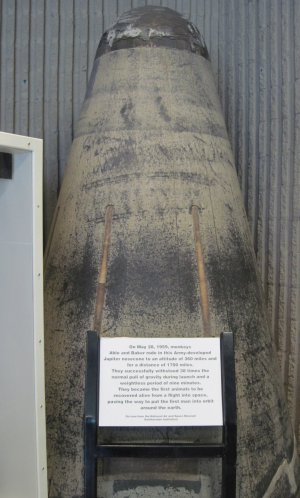 |
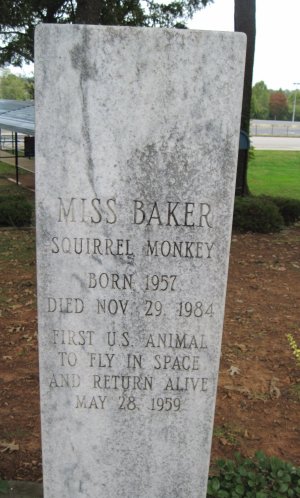 |
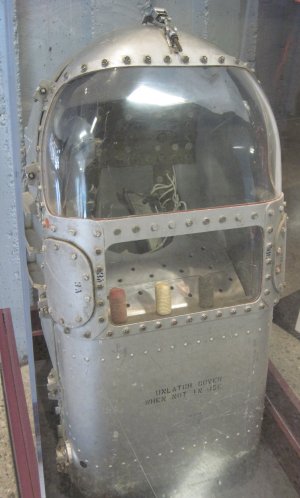 |
| Nose Cone that Returned Monkeys Able and Baker from Space on 28 May 1959. (Video) | After Her 1959 Adventure, Miss Baker Lived for Another 25 Years at the USSRC | Enclosure Used for Chimpanzee (Video) Space Flights Aboard Project Mercury Capsules |